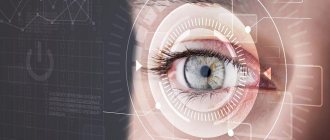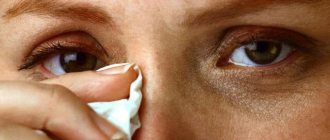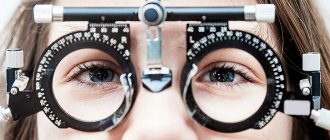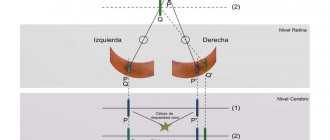Causes of eye diseases
Why does vision decrease? There are at least a dozen reasons why people experience certain vision problems, and in each case they are individual. The most significant among them are:
- Genetic characteristics (predisposition to certain diseases).
- Increased load on the visual organs.
- Gross violation of visual hygiene rules.
- Past infectious diseases.
- Endocrine diseases, including diabetes.
- Circulatory disorders.
- Pathologies of spinal development.
- Eye injuries, chemical and radiation exposure.
- Age-related diseases.
Also, in addition to the main causes of vision loss, there are additional accompanying factors that stimulate this process. Among them, doctors name decreased human immunity, lack of vitamins in the body, lack of sleep, stress, eye fatigue, smoking and drinking alcohol.
A wide range of factors influencing the acuity of our vision suggests that, to one degree or another, every person is at risk of partial or complete loss of vision.
In order to avoid such an outcome, it is very important to carry out comprehensive prevention of eye diseases.
What happens to vision?
The first symptoms of impaired visual function are considered to be the inability to qualitatively distinguish the contours of more or less distant objects, blurry pictures, a “veil” before the eyes, inability to read, etc. The loss of good quality vision is associated not only with defects in the visual organs themselves. A drop in visual acuity or loss of vision can be a symptom of serious systemic diseases of the body. The pathological condition of the eyes can be temporary (passing) or permanent, persistent.
Loss or deterioration of visual ability may be:
- bilateral - the lesion is most often the cause of a neurogenic disorder;
- unilateral - usually associated with a local problem (defect of eye tissue, local vascular pathology).
Why does vision decline rapidly, suddenly? The causes of a sharp, spontaneous loss of visual viability of the eyes (one or two) are usually classified as ophthalmological (directly related to the physiology and anatomy of the eyes) and general - those reasons that are associated with various general diseases of the body.
The loss of the main function of the eye is not always associated with organic disorders of the body.
Visual acuity may temporarily but sharply decrease due to overwork, constant lack of sleep, or prolonged exposure to a computer monitor, especially if a person’s daily work activity is associated with it.
Prevention
Knowing the reasons for vision deterioration, it is not difficult to decide on the preventive measures that are necessary to restore it. These include:
- Quitting bad habits, including smoking and alcohol.
- Regular visits to the ophthalmologist for the timely detection and treatment of any ailments (you must remember that in the early stages almost all of them can be completely cured with medication, which is practically inaccessible in the later stages).
- Protects eyes from chemical exposure and UV radiation.
- Compliance with recommendations for visual hygiene, including ensuring the proper level of lighting at home and in the office, as well as working at the computer.
- Active sports that improve blood circulation and metabolism.
- Regular exposure to fresh air.
- Gymnastics and eye massage.
- Homemade herbal baths and lotions.
All these methods are quite effective in each specific case, therefore they should in no case be ignored or considered primitive and outdated.
Also read about eye exercises for myopia here.
By using them regularly, you will be able to avoid serious illnesses and even improve your current level of visual acuity.
Why does temporary blindness occur?
Intermittent or temporary blindness (amaurosis fugax) is a phenomenon that affects a person instantly and then also suddenly passes. Patients talk about their sensations: as if in one second a curtain falls before their eyes. In other cases, loss of certain areas of vision occurs - the so-called. selective blindness that develops when certain areas of the brain are damaged. Characterized by the inability to see any individual features of objects - for example, its shape or shades.
There is also such a thing as “snow blindness,” temporary blindness caused by bright light. This condition received its name after many cases of vision loss of an antispasmodic nature from contemplating snow-covered expanses and bright sunlight, which usually lasts from several seconds to several minutes.
Only in the 21st century, thanks to the development of genetic engineering, it became possible to help patients with such a diagnosis of “congenital blindness.” All these pathologies are quite rare; even less common is congenital blindness (91 cases per 80 thousand), which until recently was considered an incurable disease.
Features of temporary vision loss
Patients testify that usually before the onset of temporary blindness, shadows sometimes appear before the eyes. Besides:
- sometimes only one eye stops seeing;
- more often people stop seeing with only one eye;
- loss of vision with a high degree of probability may resume, but in the other eye; This mainly happens with older patients suffering from vascular diseases or atherosclerosis;
- thrombosis or embolism of blood vessels appears mainly in the coronary or carotid arteries and can cause such phenomena as sudden blindness;
- blood clots entering the vessels of the eyes block the blood supply to the retina; then the clot is destroyed and blood flow is restored, after which vision returns;
- sometimes, after a short loss of vision, the patient can face such serious consequences as a stroke or heart attack.
When diagnosed with sudden blindness, a vascular study and anticoagulants (medicines that slow down blood clotting) are usually prescribed. There can be many reasons for temporary vision loss. This includes arterial embolism, temporal arteritis, and many other pathologies. It is necessary to understand that even the shortest loss of the ability to distinguish objects (literally up to a few seconds) is always caused by serious reasons, and not simply by the need to start wearing glasses or change them to stronger ones. In this case, only qualified, timely diagnostics can help preserve vision.
A working method to restore vision! You will throw your glasses in the trash in just 3 days...
Restoring vision. Real life story.
Problems that can cause temporary vision loss
Here are some of the most common causes of short-term vision loss:
- Increased intracranial pressure (ie, the pressure of the fluid surrounding the brain).
- Blockage of the spinal arteries involved in the blood supply to the visual segment of the brain can cause immediate loss of vision.
- Spasm of the eye arteries that supply blood to the retina can also cause loss of vision in one or both eyes, although much less frequently (this may be caused by too much bright light).
Patients who once experienced temporary vision loss must follow certain rules:
- do special exercises for visual acuity;
- visit an ophthalmologist periodically;
- always wear dark glasses, avoid exposing the unprotected retina to bright light;
- take vitamins as prescribed by your doctor;
- try to drink less alcoholic drinks, or better yet eliminate them completely;
- introduce more fruits and vegetables into your diet;
- walk in the fresh air and relax more often.
If you are faced with the problem of temporary vision loss, this should be a signal to you that serious problems have appeared in your body. Any vision pathology, be it temporary, sudden or selective blindness, is very dangerous. To prevent relapse or more severe consequences, contact a good specialist.
What to do if your vision has decreased
If you notice even minor symptoms of decreased vision, you should immediately consult a doctor. At your request, the ophthalmologist is obliged to conduct a comprehensive eye examination, study the conditions of your work and life, establish the reason for the loss of vision, and also prescribe a correction adequate to your case. If you take such measures in a timely manner, it is quite possible that you will be able to identify certain complex ailments in the early stages and cure them in time, thus avoiding loss of vision. If the specialist does not find any serious diseases in you, he will be able to select for you an individual method of vision prevention, using which you will be able to relieve this symptom and return to normal life.
Many people, with a slight deterioration in their vision, do not see the point of seeing a doctor and try to solve the problem using traditional methods, or completely ignore it.
Both the first and second options are not correct. The fact is that without a full diagnosis it is very difficult to establish the true cause of vision loss, and therefore it is impossible to adequately treat it. This approach, as well as ignoring the problem, can lead to complications and other unpleasant consequences.
The effect of the computer on the eyes
Studies have proven that frequent contact with a computer can negatively affect the quality of vision.
The main reasons for this:
- Dry eye syndrome. With this syndrome, unpleasant sensations arise in the form of:
- redness;
fear of light;
- feeling of sand in the eyes;
- sting.
- The monitor is too close. When a person focuses his gaze on a monitor that is too close for a very long time, visual fatigue syndrome may occur, which negatively affects vision.
All this happens because, looking at the monitor, a person begins to blink less often than expected, and this can lead to drying out of the mucous membrane of the eye.
Therefore, it is worth following some rules to preserve your vision into old age:
- The distance between the monitor and the eyes should not be less than 70 centimeters;
- Looking straight ahead, the top edge of the monitor should be visible;
- Periodically looking away from the monitor for half a minute, look at surrounding objects at different distances;
- Leave the area near the computer for 10 minutes every hour;
- Don't forget to drink plenty of liquids, preferably plain water;
- You can use pharmaceutical preparations to moisturize your eyes.
↑
Modern restoration methods
Nowadays, ophthalmology has dozens of effective methods to cope with eye diseases, regardless of their causes and general symptoms. Complete restoration of visual acuity is carried out using:
- laser vision correction;
- surgical treatment (especially for cataracts);
- drug therapy;
- correction using night lenses (for mild myopia and farsightedness).
Also, the most important tool for vision correction are contact lenses of various optical powers, which can be soft, hard, gas permeable. Selected for each patient individually.
Read more about long-term soft contact lenses here.
Prescribing any of the above correction methods is possible only after a full diagnosis by a specialist.
It is highly not recommended to independently decide on the selection of one or another remedy to eliminate vision defects, since they may not only not give a good result, but also aggravate the problem if selected incorrectly.
Causes of sudden deterioration in vision
Vision can deteriorate not only as a result of exposure to environmental factors, but also due to the appearance of various diseases of the internal structures of the eyeballs. The sooner the cause is identified, the higher the possibility of a complete cure for the patient. In the early stages, vision functionality can be restored to 100% if the damage is not too deep.
Mechanical injuries
Such injuries include:
- damage to the skull;
- brain damage that reduces the functionality of the visual center;
- disruption of the structure of the outer parts of the eyes (mucosa, cornea, conjunctiva);
- violation of the integrity of the internal structures of the eyes (lens, cameras, retina);
- decreased blood flow through the vessels, damage to the endothelium.
Bruises, scratches, punctures, bleeding, and exposure to chemicals lead to decreased vision function. The larger the area of damage, the more difficult it is to restore the tissue structure.
Bleeding inside the eyes
The condition occurs due to impaired functionality of microcirculatory vessels, mechanical damage, and excessive physical exertion. If the area of damage is small, the blood will resolve itself. With extensive bleeding, severe impairment may occur, including complete blindness, requiring surgical intervention.
Bacterial infection
Bacteria can enter from the environment or through the blood. In the second case, the condition is a complication after sepsis (blood poisoning). Bacterial conjunctivitis is a fairly common occurrence that can be quickly eliminated with antibiotics.
If left untreated, complications and infection may spread into the internal structures of the eyes.
Retinal dysfunction
It may rupture, be compressed by surrounding tissues, or peel off. With these disorders, a white veil forms before the eyes, which is visible to the naked eye. Tissue restoration is possible after surgery.
Cataract
This is a condition in which protein accumulates in the lens. It becomes cloudy and therefore loses its functionality. The lens stops refracting rays to the required extent, so vision deteriorates and cataracts develop.
Glaucoma
This is a condition in which intraocular pressure increases. The higher it is, the greater the pressure on neighboring tissues. If it spreads to the retina and optic nerve, it leads to deterioration of vision to the point of complete blindness.
Farsightedness and myopia
Farsightedness is a disease in which a person sees poorly near, but clearly in the distance. Myopia is a condition in which a person sees close up, but objects in the distance are blurry. Both conditions are capable of progression and deterioration of vision function.
Complication of diabetes
In diabetes mellitus, conglomerates of glucose and fatty substances form in the blood. They migrate to different organs and tissues. If they penetrate the microvasculature of the eyes, this causes deterioration in blood circulation. The tissues of the eyeballs cease to be nourished through the blood, and the rate of cell renewal decreases. Gradually, vision deteriorates and blindness develops.
Tips for caring for your vision
Regardless of whether you currently have diagnosed vision diseases or not, you must make every effort to avoid their occurrence in the future and help the body restore the normal state of the eyes now. To achieve this, it is vital to follow general vision care recommendations. They are common to all patients. These measures will be discussed below.
Traditional medicine (diet, diet, vitamins)
Almost all folk methods of combating vision pathologies are aimed primarily at restoring natural metabolic processes by saturating the body with additional vitamins and minerals.
Foods high in vitamins for vision
They may include:
- Correction of the diet by adding carrots (contains vitamin A), blueberries, citrus fruits, dried fruits, and beets. It is also mandatory to add dairy products to it to saturate it with essential minerals.
- The use of various infusions. For example, mistletoe (treatment of glaucoma), as well as eyebright (for various types of pathologies).
- Using various oils for eye massage, including geranium oil, burdock oil and other similar ones to which a person is not allergic. Such products also contain a wide range of vitamins, so they can have an extremely positive effect on the condition of your eyes.
- As local remedies, these methods also include medicinal compresses based on a decoction of chamomile and other herbs. In preventive measures, it is enough to carry them out twice a week.
Read more about vitamins for improving vision in the material.
It is extremely important to use traditional medicine methods to restore visual acuity as preventative measures. However, for serious diseases, including glaucoma and cataracts, it is not recommended to base treatment on them alone. This can have unpleasant consequences for your health.
Exercise for the eyes
There are more than a dozen effective exercises for various eye diseases, the daily implementation of which can give a good therapeutic effect and even increase your visual acuity. They are aimed at solving various vision problems and allow:
- Improve blood circulation in the eyes (exercise “curtains”);
- Train accommodation (all exercises aimed at consistently focusing vision on close and distant objects);
- Relax the eye muscles (butterfly exercise).
Harmonious exercise for your eyes should consist of several different types of exercises.
To get the maximum effect from it, it is recommended to perform the exercises 2 times a day at the same time.
Within a month, if you perform the exercises correctly, you can get the first result.
You can find out the current rules for choosing vision glasses by clicking on the link.
This article will tell you what progressive spectacle lenses are.
How is visual acuity tested:
Partial loss of vision: causes and predisposing factors
In 80% of cases, blindness could be avoided if patients undergo regular medical examinations and monitor their health.
Sudden blindness in both eyes is rarely diagnosed. It can be caused by cytomegalovirus or AIDS. More often, the patient does not see in one eye or the field of vision is reduced. Vision loss can be complete or temporary. Severe blindness, lasting no longer than 20 minutes, may be a sign of complete loss of vision in the near future. Factors that cause vision loss in one eye:
- Spasm. When the ophthalmic artery is compressed, the retina does not receive the necessary nutrition and cannot perform its functions. This usually happens when a person is looking at a very bright light.
- Blockage of the vertebral arteries. The pathology develops against the background of atherosclerosis or vascular damage by osteochondrosis.
- Increased intracranial pressure. In this case, disruption of the functioning of the ocular apparatus is observed when the patient is standing.
Ischemic neuropathy
The cause of vision loss in one eye may be atherosclerosis.
The pathology is characterized by sudden loss of vision in one eye without pain. In most cases, the causes of neuropathic blindness come down to atherosclerosis; less often, pathology occurs against the background of severe anemia and hypotension. The disruption of the eye lasts a few minutes and is completely restored. The patient exhibits symptoms of diseases of the cardiovascular system, allergic or infectious process.
Overwork
Due to prolonged stress on the eyes, asthenopathy occurs, which threatens blindness. In addition to the sudden loss of vision, the patient experiences pain in the eyeballs, profuse lacrimation, and headaches. Causes of asthenopathy:
- reading in low light;
- constant long-term work on a PC;
- driving at night;
- watching TV and using electronic gadgets for more than 4 hours in a row.
Optic neuritis
In most cases it provokes pain. Discomfort increases when moving the eyes. More often the disease occurs in people suffering from multiple sclerosis. The patient's visual acuity in the left or right eye sharply decreases, followed by its recovery. Such changes are observed for up to 3 months, after which the disease can develop into optic nerve atrophy.
Retinal migraine
During a migraine, vision loss occurs for a short period of time.
The disease belongs to associated migraines. During an attack, short-term loss of vision is observed. Prerequisites for exacerbation are:
- distortion of visible objects;
- reduction of visible area;
- deterioration of visual acuity;
- a flickering stripe in one part of the field of view.
What other causes of partial blindness could there be?
Older people have an increased risk of vision loss. Neglecting medical examinations is dangerous.
If a person's eyes are blind, they should immediately go to the hospital. Timely detection of the cause of the pathology will help restore vision. If the eye suddenly stops seeing, there is an explanation for this. Often the functionality of the visual system deteriorates with cataracts or glaucoma. In addition, the following causes of vision loss are distinguished:
Partial blindness can be caused by clouding of the cornea.
- Keratitis. There is inflammation and clouding of the cornea.
- Diabetic retinopathy. The eyes lose functionality due to severe circulatory disorders.
- Infection of the eyeball.
- Onchocerciasis. Parasites damage the eyes.
- Head or eye injuries. Damage to the back of the head is especially dangerous.
- Poisoning. Contact with chemicals leads not only to blindness, but also to death.
- Use of oral contraceptives. Hormonal drugs can provoke the development of thrombosis and glaucoma.
conclusions
As we can see, both in medical and folk practice there are a lot of effective recipes that can save a person from vision problems. And, unfortunately, no one is immune from them, but there are effective methods, although not to prevent, but to slow down the process of vision loss. This includes eye exercises, vitamin eye drops to improve vision, and traditional medicine. All that is needed to cure such ailments is to pay attention to the problem in a timely manner and begin its effective treatment. In this case, you will definitely achieve positive results in this matter.
List of possible pathologies
With age, both men and women experience a decline in vision. In 90% of cases, going to the doctor occurs late, since people are accustomed to thinking that the main problems are myopia or farsightedness.
Experts identify several pathological changes that can lead to deterioration in the functions of the visual organs.
Presbyopia
The disorders represent a complex of pathological changes in the health of the eyes. In most cases, ophthalmologists mean by this term an age-related decrease in the accommodative functions of the lens. This happens because the structure is changing.
A complete diagnosis is necessary, since the course of the disease occurs individually in each person. In some cases, it can manifest itself as glaucoma in the early stages, and then develop into progressive myopia. After 55-60 years, senile cataracts are observed, which arose against the background of previous changes.
Timely initiation of therapeutic interventions can reduce the risks of presbyopia. As a result, up to 70% of lost visual acuity can be restored.
Cataract
The change is recorded in 70% of older people. The main reason: a decrease in amino acids, proteins and active enzymes entering the eyes. These substances ensure stable functioning of the visual organs and protect them from negative influences. If changes are recorded, they are expressed in clouding of the lens.
The disease has 4 stages:
- initial – myopia is mild, there are slight opacities of the lens;
- immature – there is a slow decrease in the clarity and acuity of vision, the processes of clouding of the lens intensify;
- mature - the lens loses fluid and decreases in size, vision decreases significantly (it is impossible to distinguish colors and shapes of objects);
- overripe - the lens dries out, cloudiness is clearly expressed, vision is lost by 90%.
It is necessary to start the treatment process in the early stages, as this will help avoid blindness.
Glaucoma
The disease occurs as a result of long-term problems with increased intraocular pressure. The development of pathology occurs against the background of age-related physiological changes associated with the organs of vision. The main negative impact is aimed at the lens and retina. The disease occurs in 30% of people over 70 years of age. At the age of 45 years, such disorders are noted by doctors in 1% of all calls.
Diabetic retinopathy
If this pathology develops, significant damage to the retina is observed. The disorder is recorded in people with type 1 diabetes; if type 2 is diagnosed, the likelihood of the disease is reduced by 50%. Feature: a serious complication – complete loss of vision (blindness).
Diabetic retinopathy can be avoided by starting therapy in a timely manner according to the existing symptoms.
Macular degeneration
Retinal macula atrophy is observed. Visual acuity drops by 50-70%, but blindness is not observed even in the most severe cases. If this pathology develops, a person cannot perform usual functions (reading, driving a car). The ability to distinguish colors is also lost. The main direction of treatment is surgery.
Amblyopia
In the case of amblyopia, there are differences in the refraction of light in the eyes. The problem can be congenital or appears after strabismus. As a result of the development of pathology, a person’s clarity of image perception decreases or a feeling is created that one eye sees worse than the other.
Astigmatism
The problem is due to the fact that the fundus of the eye becomes oval. Focusing of vision is impaired, the contours of objects become blurred. As a result of deterioration of the condition, strabismus appears and visual acuity decreases.
My vision has deteriorated - what should I do?
When the first symptoms of deterioration in visual acuity appear, try to undergo a full diagnosis as quickly as possible in a well-equipped ophthalmology clinic. Modern equipment and qualified personnel greatly increase the chances that you will receive the necessary assistance in a timely manner.
What should I do if my vision decreases? Get a full examination to look for the causes of possible pathology. Diagnostics:
- determination of visual acuity using the table;
- examination of the fundus (dilated pupil);
- keratorefractometry;
- testing contrast sensitivity, color perception;
- biomicroscopy of the anterior segment of the eye.
Usually, people who have suffered from myopia for a long time complain of deteriorating vision after the age of 40, without even suspecting that it is not myopia that is developing, but age-related farsightedness. With true hyperopia, such processes are noticeable immediately after 40 years, and myopic people may not notice the signs of age-related farsightedness for a long time.
I am developing both myopia and farsightedness - what should I do?
An excellent correction option is to wear glasses with progressive lenses or multifocal contact lenses with several optical zones for close, medium and far distances. In case of severe myopia and age-related farsightedness, the selection of glasses and lenses should be carried out by a highly qualified doctor, especially if a prescription for progressive lenses is needed.
If the new prescription has not improved my quality of life and I still have difficulty seeing, what should I do? People who are nearsighted and develop farsightedness may be offered intraocular lens implantation. Modern lens models are thin, elastic, and have a memory function. They are implanted in a folded form through a micro-incision, which heals without stitches, and takes the desired position inside the eye.
How can I maintain my vision after 40? To prevent myopia from progressing after 40 years, it is necessary to pay attention to prevention. Do eye exercises, take multivitamins with blueberry extract and lutein. Contact an ophthalmologist who will prescribe effective eye drops with vitamins if your vision deterioration is accompanied by unpleasant symptoms.











